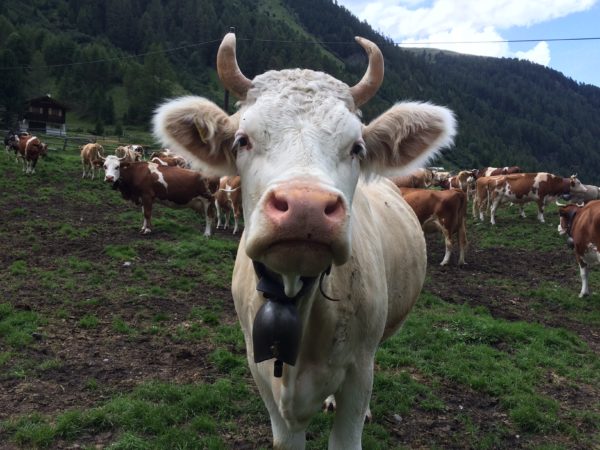The quaint valley of Turtmann is as good a place as any to learn about swiss cows and cow products. I first encountered it while hiking the Chamonix to Zermatt Haute Route. At the Alpe Blüomat farm, friendly farmers welcome visitors to witness the processes of milking and cheesemaking, as long as you arrive on time. The swiss cows are as punctual as the trains in Switzerland.
IT’S ALL ABOUT THE MILK
I can’t think of Switzerland without thinking of mountain meadows full of cows, I’m a sucker for them. Think about it: cheese, Rivella, beef, cream, and yogurt. Switzerland is famous for these products. So what’s a day in the life of a Swiss cow? Well, it’s all about the milk.

UNTIL THE COWS COME HOME
The afternoon milking at Alpe Blüomatt starts at five o’clock, so the Swiss cows are called home at four. Don’t expect to drive down the narrow mountain road while they are en route. You may find that you become an expert cow-herder, simply out of necessity. That, or you’ll enjoy a half-hour delay with the lovely sound of cowbells, while you wait for them to mosey on down the road. The great thing about Swiss cows is that they’re used to human contact, so there’s no need to worry about being to close. Hikers are constantly passing through brown cattle pastures and shooing them back to the herd when they stray beyond the boundaries. Usually, a tap on the cow’s hip is all you need to help her on her way.
By the way, did you know that most female cows have horns? All the cows pictured here are milking cows: every last one is a female. Most American dairy farms remove their cows’ horns to prevent aggressive cows from injuring others in the herd, but the Swiss just let them grow.

When the cows are ready for milking, they are guided into a special room with milking stalls. The farmer stands between two rows of milking stalls in a rut that is lower than the cows, so as to easily have access to the utters. Once the farmer applies four suctions columns, also known as teat cups, the cow patiently munches on grain while a pulsating vacuum system relieves her of the built-up milk in her utters.

The milk flows through a hose, into a cooling vat in the next room. Jürg, the cheesemaker at Alpe Blüomatt, explained that immediate cooling is an essential part of the process. If the milk isn’t cooled right away, the bacteria in it will start to grow and it will become dangerous for consumption. The cooling vat used is so effective that my sample of the milk scooped out as warm milk, was still flowing in and was already cold! That’s quite impressive considering the amount of milk the vat holds. Each cow produces between 10 and 25 liters per milking. That’s 20-50 liters from each cow every day, a total of 1300 liters a day from the herd (about 345 gallons)! What do you do with all that milk? None of it goes to waste in cow country.

DON’T BE SO CHEESY
For cheese-making, it is the curdling agent that separates the milk into curds and whey. In the vat, the curds are sliced into cubes using wires. The whey is then drained off, and the curds are placed into cheese pots, like the ones pictured above. The pots have weighted lids that keep pressure on the curds and force out the extra whey, which is collected in a bucket. A band around the cheese embeds the name of the valley (Turtmanntal) into each wheel of cheese. The cheese is then stored on wooden boards until it is properly aged and ready for the tasting.
YES WHEY
The Swiss don’t waste any part of the milk. Whey, the yellowish runoff that separates from the curds, is full of protein and vitamins and can be used to make other milk products. Ricotta cheese is made from whey, as is Rivella. Rivella is a famous Swiss soda that is delicious and truly unique in its flavor and origin. Who would have thought of making soda from milk? Small farms make their own Rivella-type juice by adding fruity flavors to the whey. It’s a delicious, nutritious drink. For a first-hand cheesemaking experience, come to Eigeralp with us! Our Best of the Swiss Alps, Exploring the Jungfrau, and Swiss Bliss tours all include a stop at the traditional alpine farm!
- Classic Rösti Recipe - September 5, 2017
- A Day In The Life Of Swiss Cows On The Alpe Blüomat Farm - August 29, 2017



I have been to Switzerland and loved to pass the cows grazing with bells on. They seem to have a very humane life. I had to become vegan in the states since dairy comes spend their life in stalls, forced insemination and babies are separated at birth from its devasted mother. I can’t eat cheese from a place that operates like this. What can you tell me?
All the Swiss cows we have encountered in the Alps lead very comfortable lives and are treated with dignity.
beautiful cows,wonderful milk and cheese.god bless the alps mountains
Yes! The Alps are wonderful!
Awesome. Voila!!!